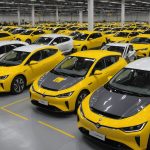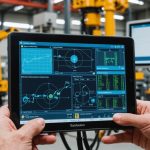Transforming Urban Rush Hour: The Game-Changing Impact of AI on Traffic Control
As cities continue to grow and urbanization accelerates, managing traffic efficiently has become a critical challenge for municipal authorities. The integration of artificial intelligence (AI) into traffic control systems is revolutionizing the way cities handle their transportation networks, making urban mobility safer, more efficient, and sustainable.
The Role of AI in Traffic Management
AI is not just a buzzword; it is a powerful tool that is transforming various aspects of urban management, including traffic control. Here’s how AI is making a significant impact:
Topic to read : Transforming industrial automation: essential innovations in sensor technology you must explore
Advanced Detection and Enforcement
The new generation of urban traffic radars, equipped with AI, goes beyond mere speed monitoring. These sophisticated devices can detect multiple infractions simultaneously, such as:
- Excessive Speed: AI-powered radars can accurately measure the speed of vehicles and issue fines accordingly.
- Red Light Violations: These radars can capture images of vehicles crossing intersections when the light is red.
- Use of Mobile Phones While Driving: AI can identify drivers using their phones, a significant safety hazard.
- Failure to Wear Seatbelts: The system can detect if drivers or passengers are not wearing seatbelts[1][3][4].
This multi-faceted approach enhances the effectiveness of traffic enforcement, leading to a significant increase in the number of infractions detected and a subsequent reduction in dangerous driving behaviors.
Also to read : Unleashing the future: groundbreaking lithium-sulfur battery innovations transforming electric vehicles
Impact on Traffic Flow and Congestion
The deployment of AI-driven traffic management systems has several direct benefits on traffic flow and congestion:
Real-Time Data Analytics
AI systems can analyze real-time data from various sources such as traffic cameras, sensors, and GPS data to optimize traffic flow. Here’s a detailed look at how this works:
| Aspect | Impact |
|---|---|
| Traffic Signal Control | AI adjusts traffic signals in real-time to minimize congestion and reduce travel times. |
| Route Optimization | AI suggests the most efficient routes to drivers, reducing overall traffic volume on congested roads. |
| Predictive Maintenance | AI predicts and prevents infrastructure failures, ensuring that roads and public transport systems are always operational[2][5]. |
For instance, the city of Dijon has implemented a central control center using AI solutions to manage traffic, public lighting, and waste collection. This has led to better coordination of municipal services and a reduction in energy costs[2].
Smart Traffic Signal Management
AI can optimize traffic signal timing based on real-time traffic conditions. Here are some ways this is achieved:
- Dynamic Signal Timing: AI adjusts the duration of green lights based on the volume of traffic approaching the intersection.
- Traffic Prediction: AI algorithms predict traffic patterns and adjust signals accordingly to reduce congestion.
- Integration with Public Transport: AI ensures that traffic signals prioritize public transportation, such as buses and trams, to encourage the use of more sustainable transport options[2][5].
Enhancing Urban Safety
The safety of urban residents is a top priority, and AI is playing a crucial role in enhancing it:
Automated Surveillance
AI-powered surveillance systems can monitor urban areas continuously, detecting and responding to safety threats in real-time. Here are some examples:
- Crime Detection: AI can analyze CCTV footage to detect and alert authorities to potential crimes.
- Accident Detection: AI can identify accidents and alert emergency services immediately.
- Pedestrian Safety: AI can monitor pedestrian crossings and adjust traffic signals to ensure pedestrians have sufficient time to cross safely[2].
Data-Driven Decision Making
AI helps in analyzing vast amounts of data to identify trends and patterns that can inform public policy. For example:
- Demographic Analysis: AI can analyze demographic data to predict future needs in urban planning.
- Traffic Accident Analysis: AI can analyze data on traffic accidents to identify high-risk areas and implement safety measures.
- Public Health: AI can analyze data on public health trends to optimize healthcare services in urban areas[2].
The Future of Urban Mobility
As AI continues to evolve, it is set to transform urban mobility in several ways:
Autonomous Vehicles
Autonomous vehicles, powered by AI, are being tested in various cities around the world. These vehicles can navigate through urban areas without human intervention, reducing the risk of accidents caused by human error.
Key Benefits of Autonomous Vehicles:
- Reduced Traffic Congestion: Autonomous vehicles can optimize traffic flow by maintaining consistent speeds and reducing the need for traffic signals.
- Enhanced Safety: Autonomous vehicles can detect and respond to hazards more quickly than human drivers.
- Increased Mobility: Autonomous vehicles can provide transportation for the elderly and disabled, enhancing their mobility and independence.
Smart Cities and Public Transportation
AI is integral to the concept of smart cities, where technology is used to make urban living more efficient and sustainable. Here’s how AI is improving public transportation:
Examples of AI in Public Transportation:
- **Route Optimization**: AI optimizes bus and train routes to reduce travel times and improve the efficiency of public transport systems.
- **Predictive Maintenance**: AI predicts when maintenance is needed for public transport vehicles, reducing downtime and improving reliability.
- **Real-Time Information**: AI provides real-time information to commuters about traffic conditions, bus and train schedules, and service disruptions.
Practical Insights and Actionable Advice
For cities looking to implement AI-driven traffic management systems, here are some practical insights and actionable advice:
Invest in Data Infrastructure
Cities need to invest in robust data infrastructure to support AI systems. This includes installing sensors, cameras, and other data collection devices.
Key Steps:
- Install traffic cameras and sensors to collect real-time data.
- Implement data analytics platforms to process and analyze the data.
- Ensure data security and privacy to maintain public trust.
Collaborate with Private Sector
Collaboration with the private sector can bring in the necessary expertise and resources to implement AI solutions effectively.
Benefits of Collaboration:
- Access to Advanced Technology: Private companies can provide cutting-edge AI technologies.
- Expertise: Private sector experts can help in implementing and maintaining AI systems.
- Funding: Private investment can help in funding large-scale AI projects.
Public Awareness and Education
Public awareness and education are crucial for the successful implementation of AI-driven traffic management systems.
Key Strategies:
- Educate the public about the benefits of AI in traffic management.
- Provide real-time information to the public about traffic conditions and service disruptions.
- Encourage public feedback to improve the system continuously.
The integration of AI into traffic control systems is a game-changer for urban mobility. It enhances safety, reduces congestion, and makes transportation more efficient and sustainable. As cities continue to evolve, the role of AI will become even more pivotal in creating smart, safe, and sustainable urban environments.
In the words of a city official from Dijon, “AI is not just a tool; it is a partner in our mission to create a better, more livable city. With AI, we can anticipate needs, optimize resources, and make our city safer and more efficient for all residents.”
As we look to the future, it is clear that AI will play a central role in transforming urban rush hour, making it faster, safer, and more enjoyable for everyone.











